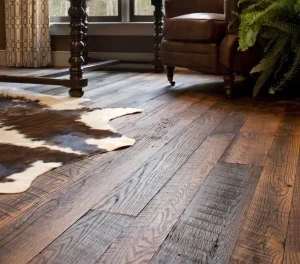Rustic white oak floor delivers a unique character that blends natural charm with enduring quality. Known for its distinct grain patterns, knots, and color variation, this flooring option adds personality to modern, traditional, or farmhouse-style interiors. Its rugged appearance doesn’t compromise performance—instead, it offers a combination of authenticity and practicality that continues to gain popularity in both residential and commercial designs.

Understanding the Aesthetic Appeal
Rustic white oak floors showcase the wood’s natural features rather than hiding them. This includes mineral streaks, filled cracks, and knots, which make each plank visually unique. The appeal lies in the imperfections, giving rooms a grounded, lived-in look that can’t be replicated with synthetic materials.
Color Variations and Natural Tone
White oak naturally exhibits a neutral to warm undertone, ranging from light tan to golden brown. Rustic versions often emphasize these tones through surface treatments like wire brushing, hand scraping, or smoking. These methods enhance the grain and create subtle depth in both color and texture.
Grain Texture and Visual Movement
The grain in white oak is relatively straight but dense, which allows for both subtle and pronounced variations. Rustic cuts tend to have more visible grain swirls, cathedrals, and rings that add a dynamic visual flow across the room.
Construction and Finish Options
Rustic white oak floors are available in both solid hardwood and engineered constructions. The choice depends on the installation site and budget, but both options retain the same rustic charm and durability.
Solid vs. Engineered Structure
Solid white oak planks are milled from a single piece of timber, providing longevity and the ability to refinish multiple times. Engineered planks have a hardwood veneer over a plywood core, offering better resistance to moisture and temperature changes—ideal for basements or radiant heat settings.
Surface Finishing Techniques
Rustic floors often use oil-based finishes or hardwax oils to preserve the natural feel of the wood. Matte finishes are the most common for this style, as they reduce glare and help highlight the organic texture of each board.
Applications in Interior Design
Rustic white oak flooring is adaptable to a wide range of interiors. It brings warmth and depth to open-plan spaces, bedrooms, dining areas, and even commercial showrooms looking to project an inviting atmosphere.
Modern Rustic Fusion
Pairing rustic oak flooring with minimalist furniture or industrial lighting creates a visually balanced contrast. The rustic floor softens the hard edges of contemporary interiors, adding visual interest without overwhelming the space.
Farmhouse and Vintage Appeal
In traditional or farmhouse settings, rustic oak enhances the lived-in aesthetic. It works well with exposed beams, antique furniture, and natural textiles. The imperfections in the wood floor tie into the overall narrative of heritage and authenticity.
Installation and Maintenance Tips
Rustic white oak floors require careful handling to preserve their character during installation. Proper acclimation and substrate preparation are essential for a stable and long-lasting result.
Site Preparation and Acclimation
The wood should be left in the installation environment for several days to adjust to humidity levels. Subfloors must be clean, dry, and level to prevent shifting or squeaking after installation.
Cleaning and Care Recommendations
Daily maintenance includes sweeping or vacuuming with a soft brush attachment. Use wood-safe, pH-neutral cleaners and avoid excessive water exposure. Protective felt pads under furniture and entry rugs can help prevent scratching.




